Today, Ethernet is a mature technology in the automotive industry that continues to adopt and integrate the ISO 13400 Internet Protocol Diagnostic Communication (DoIP) protocol. This trend is providing rapid reprogramming speeds through standard Ethernet physical interfaces. Of course, if Ethernet is widely accepted as a general standard for in-vehicle network buses, there are still some problems that need to be solved.
Advanced Driver Assistance Systems (ADAS), especially the more attractive camera systems, are just one of many applications in the industry that seek to take advantage of the many advantages of Ethernet. In this article, we will analyze the challenges of automotive Ethernet and illustrate a mature Ethernet-based ADAS sensor solution.
Why choose Ethernet in ADAS?
Why designers should consider Ethernet-based connectivity may not be obvious, as there are many very mature options available, such as analog and LVDS interface technologies. Using Ethernet may increase processing costs, but the use of low-cost unshielded cables can significantly reduce cable costs. Moreover, the standard 100BASE-TX Ethernet is powered by Power over Ethernet (PoE) without the need for an additional power cable. It is worth noting that Ethernet provides a unified, universal in-vehicle network that provides seamless cross-domain communication through both universal data streams and physical media (cables). This technology eliminates the need for bridging and thus radically reduces cost and complexity.
ADAS camera system challenge
The ADAS camera system is designed to face the major challenge of in-vehicle connectivity and is arguably one of the most demanding applications in the automotive field.
Small size
The development of the camera and sensor market for industrial and automotive applications has created an increasing number of space constraints.
Low power consumption
The thermal noise generated by the camera sensor will directly affect the image quality. Improving thermal power consumption, avoiding the necessary space constraints, and reducing power consumption are critical to achieving the desired performance.
Low noise
Just like thermal noise, electrical noise can also degrade the image quality of the sensor. In addition, it is best to meet industrial EMC emissions requirements without the use of costly cables such as fiber optics or shielded cables.
High reliability
Provides the necessary performance in extreme environments.
To demonstrate that standard Ethernet meets the requirements of the ADAS camera system, Micrel and automotive sensor specialist Silicon Micro Sensors GmbH (Mobile Division of First Sensor AG) have designed a small “can be put into production†for the most demanding applications. Automotive and industrial grade solutions:
High dynamic range (HDR) megapixel (720p) camera
Field of view between 55° and 190°
MJPEG video compression
Ethernet AVB compatible bitstream (MJPEG or UDP)
Support for Power over Ethernet
Speed ​​on low-cost unshielded twisted pair can exceed 100Mbps
Meets IP68 / IP6k9 standards, waterproof, scratch-resistant, anti-fog
The camera system solution is one of many ADAS designs using Micrel's Quiet-WIRETM Ethernet and Auto-PoE technology. The basic functional block diagram of the Micrel / SMS solution shown in Figure 1 below is common in all standard Ethernet camera system designs.
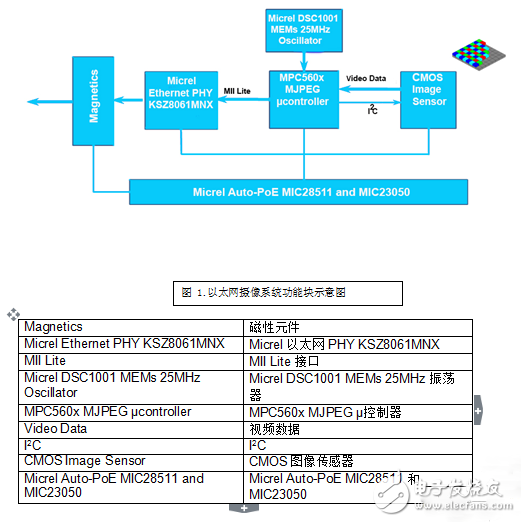
Challenge
The Ethernet physical layer offers a range of advantages to meet the needs of ADAS camera systems.
Reduce bill of materials (BoM) and reduce size

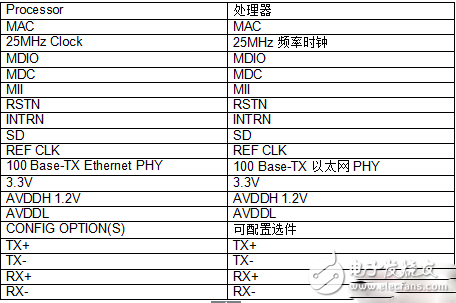
An important advantage of using a standard automotive Ethernet solution is that it provides a minimum standard bill of materials that is independent of the application, as shown in Figure 2 below. This provides economies of scale that can exceed any automotive-specific solution, resulting in a multi-vendor model that offers a wider choice and lower cost.
The physical layer is provided by a Micrel KSZ8061 Quiet-WIRETM 100BASE-TX Ethernet transceiver measuring only 5mm x 5mm. The need for a nominal power supply filter has surprised many designers that the line interface between the PHY transceiver and the magnetic components does not require additional passive components. This reduces signal cost and PCB board space while improving signal integrity.
Standard Ethernet magnetic components can also be deployed. In recent years, qualified Ethernet magnetic components for automotive applications have become widespread. Micrel has adopted TDK's latest automotive Ethernet transformers and common mode chokes. The ALT4352 series offers a surface mount, winder-wound, and smaller solution with a maximum height of only 2.9mm. This is ideal for space-constrained camera system modules. Compared to conventional hand-wound coils, the magnetic components wound by the winding machine not only reduce the cost, but also improve the accuracy. All of this helps to provide consistently stronger performance.
Powered by Ethernet for free!
100BASE-TX magnetic components are not only critical to achieving performance, but are also a must-have component for delivering power. According to the IEEE 802.3af/at "phantom power supply method", the current installation of additional cables to power remote sensors is no longer required, and power can be supplied only by the DC voltage supplied through the center tap of the magnetic element. In addition, this approach can be further optimized when used in automotive applications, providing all the benefits without any additional system cost. First, since the car wiring is fixed, it is no longer necessary to use a bridge rectifier. Second, there is no need to use an unusually expensive PoE controller. The power-receiving device (PD), in this case the camera, is fixed and has a known power consumption, so there is no need to use a relatively expensive controller to match the power-side device (PSE) to coordinate power requirements. As shown in Figure 3, a camera power management solution can be implemented simply by providing a standard DC-DC regulator. The Micrel MIC28511 60Vin 3A Synchronous Buck Regulator with Hyper Light LoadTM technology provides a primary step-down voltage to ensure efficient operation at low output power conditions such as standby.
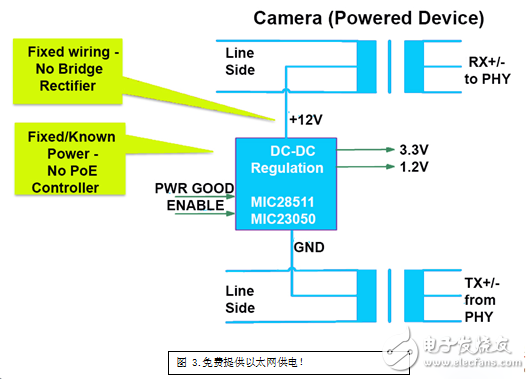

Other benefits of the “phantom power†approach include common mode noise rejection at the camera (PD), galvanic isolation between the camera (PD) and the ECU (PSE) ground, which prevents radiation due to potential differences. Ground loops, this problem has become commonplace in automotive applications. Interoperability can also be achieved by connecting to any other IEEE 802.3af/at powered device.
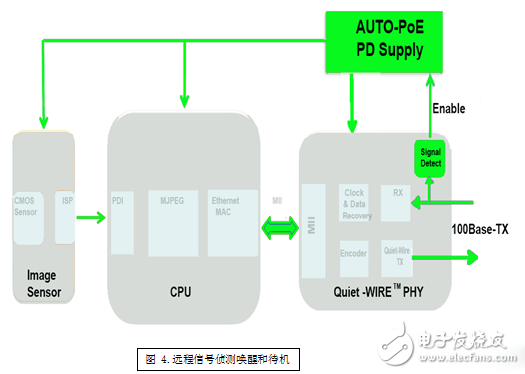

Low power consumption and high energy efficiency
In today's market, 100BASE-TX Ethernet has become one of the lowest power PHY technologies. Power and cost are reduced by a factor of three compared to solutions based on Gigabit technology. The camera system solution also benefits from the Micrel KSZ8061's support for IEEE 802.3az Energy Efficient Ethernet (EEE), which offers the industry's best ultra-low standby current of less than 1uA, making it ideal for all battery applications such as automotive.
The KSZ8061 PHY provides a unique signal detection output pin to indicate the presence of the active peer, as shown in Figure 4. The PHY standby mode is automatically activated and awakened by the signal detection circuit. In addition, power management can be used to deploy output pins to turn off the processor and sensor, providing less than 1uA of remote standby and wake-up current to the camera system module.
Low noise and high reliability
Compared to unshielded twisted pair, Micrel Quiet-WIRETM technology with KSZ8061 Ethernet PHY reduces EMI line emissions and improves interference immunity, meeting automotive OEM EMC standards. Low cost cables such as CAN or FlexRay can be used. In addition, the untwisted section of up to 5 cm can be lapped manually on each joint without the need for a protective layer, thereby keeping costs as low as possible.
To meet the needs of safety-critical ADAS applications such as reversing cameras, the KSZ8061 is capable of powering up and connecting within 20ms without processor intervention. The KSZ8061 Transceiver Signal Quality Indicator (SQI) also continuously monitors harness quality in real time.
to sum up
With the continuous efforts of countries around the world to improve road safety with the support of government supporting legislation, automotive advanced driver assistance systems are undergoing significant development. The challenges faced by ADAS, or more precisely, camera sensors, are extremely critical; not only do they meet the most stringent safety, quality and reliability standards for passenger and industrial vehicles, but also with improved power consumption, lowest electrical noise and Increased space limit requirements. Despite these challenges, Standard Ethernet has repeatedly proven its ability to provide additional benefits.
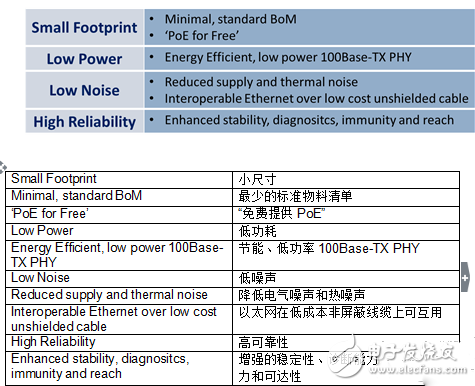
The ability to meet the ultimate key challenges of ADAS requirements and coping costs is evident in examining the advantages of standard Ethernet. Any solution that is to succeed in the market must be commercially viable. This reality is critical to the continued success of controlling total cost of ownership.
Compatible with iphone 7 4.7 inch ONLY, Model: A1660, A1778, A1779.
Compatible with iphone 7 plus 5.5 inch ONLY, Model: A1661, A1784, A1785.
Troubleshoot the damaged, cracked,shattered screens, or screens with display or touch response issues.
Double-test before shipping, three-month return policy & warranty.
The LCD does not come with any home botton, ear piece or front camera; needs carefully removing from the original screen to the new one.
Please look for technician if you are lack of installing experience.
iPhone 7 Plus LCD,iPhone 7 LCD Display,iPhone 7 LCD Digitizer Replacement,iPhone 7 Plus LCD Digitizer
Shenzhen Aokal Technology Co., Ltd. , https://www.aokals.com